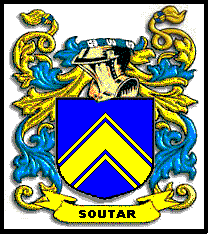
The Soutar
Web Pages
|
The Soutar Web Pages
|
|
|
Family History - Duncan Currie Patterson
The 3rd Militia being put on active duty for service in the Boar War, Duncan was sent to South Africa and upon his return he married Mary Conchie in Dennistown, Glasgow Scotland, on the 12th of July, 1900. Their first child, a girl, Barbara Janet was born on June 5th, 1901 named after Mary's Mother Barbara and her Great Great Grandmother Janet MacKenzie. Their second child born on September 15 1903, also a girl was named Elizabeth Currie after Duncan's Mother. Then followed Duncan and Mary's first son which they named William after Duncan's father, born January 7th, 1906. After came Simon John (lan) on October 25th, 1907, named after Mary's Grandfather and her brother who also bear the name Simon. Duncan Currie Patterson Jr., was born on October 17th, 1908. Christina Frazer Patterson the last child to be born to Duncan and Mary entered into this world on February 23rd, 1913. After much discussion the family came to the decision to move to Canada prior to the birth of Christina so that their children might have better opportunities in life. Duncan sailed for Canada late in the year 1912, with the promise to his wife and family to have them with him within the year. However with low wages and hard times it took Duncan two years to send Mary enough money for their keep and passage for the whole family. Shortly after WW I broke out in September 1914, Mary finally was able to finish off her business in Glasgow Scotland enabling her to sail for Canada to join her husband with her six children in tow. Prior to Mary's arrival in Canada, Duncan joined the 79th Cameron Highlanders Militia in Winnipeg, Manitoba, as a means to while away the lonely hours and months while his wife and he were saving up enough money for her and the children's passage to Canada. He was taken up in the challenge of war and proceeded to Valcartier, Quebec, with the Militia to join up with the active Expeditionary force. He found himself being attached to the 16th Battalion (Canadian Scottish) assigned to leave for the front in France, upon signing his attestation papers. "All over in six months" was the talk. "Not more than a year at the most" said many of the men excited to serve their King and new Country. Knowing that his wife Mary was on her way to Canada a the steam ship with his family, Duncan must have been upset when the unit sailed on October 3rd, 1914. On their way down the Saint Lawrence River, in the dead of night word spread through the ship that they were about to pass a steam ship carrying families coming to Canada from Scotland. Duncan asked permission to see his Commanding Officer and explained to him that he had not seen his wife for over two years and if it would be possible to contact the passenger ship. The officer understood the situation and a human voice was heard to travel across the waters of the Saint Lawrence River to the passenger ship. "Is there a Mary Patterson aboard, your husband Duncan wishes to talk to you. Is there a Mary Patterson aboard" Duncan screamed "Mary" from the rails. "Duncan is that you." "Yes" came a voice growing fainter in the black night. After arriving in England for some training of the troops and a short stay at Lark Hill training area, the 16th Battalion sailed for France in February of 1915, arriving at the port of Le Havre after crossing the English Channel. They proceeded to the front at Fleurbaix, France, near the Belgium Border. The Battalion entered into action near Fleurbaix on the 3rd of March, 1915. Duncan being plagued by dysentery was taken by field ambulance on the 3rd of March, 1915, for treatment and released a few hours later to return to the trenches at the front near Fleurbaix. Excerpts from "The History of The 16th Battalion (The Canadian Scottish) Canadian Expeditionary Force in the Great War, 1914 - 1919" read:
Duncan Patterson was officially listed as killed in action on the 14th day of March, 1915, however the Press dispatch released across Canada in all Canadian newspapers, Globe and Mail, March 26th, 1915, Winnipeg Tribune, March 25, 1915, specifically states that he was killed in action on the 5th day of March, 1915. Also the photo copy of the original army records of his death show signs of tampering or at least a mixed up jumble of dates. Mary Conchie Patterson did not receive notification of his death until March 25th, 1915, in a telegram. Duncan Patterson's name is listed in The Remembrance Book, page 32 located in the Peace Tower, Parliament Buildings, Ottawa. This page appears for viewing on January 29th of each year. Researched and written by Robert Soutar (Sr.) |
|
Last Updated: October 01, 2006 07:51:54 PM |